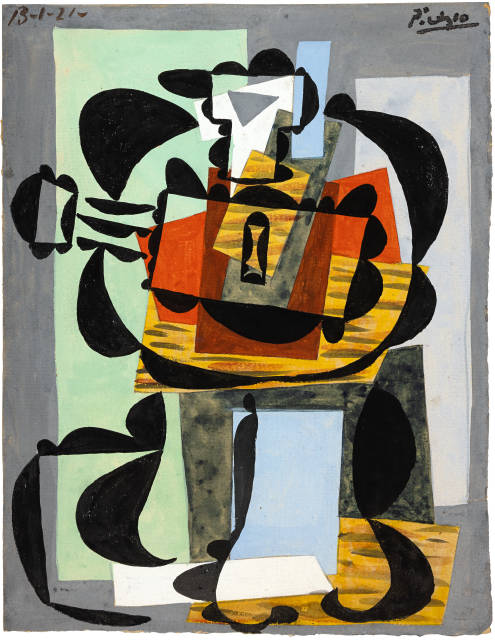- EN
Log in
- Live Auctions
- Past auctions
- More
- Gallery
- Art Dealing
- Publishing
- Kornfeld today
- The Story of Kornfeld
- Information





1921
Gouache on wove paper
27.5x21.3 cm
Signed by the artist in Indian ink at the upper right "Picasso" and dated "13-1-21" on the left
Christian Zervos, Pablo Picasso, Supplément aux années 1920-1922, Paris 1975, vol. 30, no. 132
Galerie Aktuaryus, Zurich, purchased there before 1939 by
Eliane Gribi-Chiodera Collection, Trübbach
Auktion Kornfeld & Klipstein, Bern, 22 June 1979, lot 971, acquired there by
The Eberhard W. Kornfeld Collection, Bern, with the collector's stamp on the reverse, Lugt 913b
Bern 1989, Kunstmuseum Bern, Von Goya bis Tinguely, Aquarelle und Zeichnungen aus einer Privatsammlung [Slg. Eberhard W. Kornfeld], cat. no. 103, ill. p. 189
Davos 1998/1999, Kirchner Museum, Werke aus der Sammlung Eberhard W. Kornfeld, cat. no. 47, ill.
Bern 2001/2002, Kunstmuseum, Picasso und die Schweiz, cat. no. 72, ill.
Madrid 2003, Fundación Juan March, Espíritu de modernidad: de Goya a Giacometti, Obra sobre papel de la colección Kornfeld, cat. no. 34, p. 133, ill. p. 67
Vienna 2008/2009, Albertina, Wege der Moderne, Aus der Sammlung Eberhard W. Kornfeld, cat. no. 36, p. 291, ill. p. 36
Bern 2010, Zentrum Paul Klee, Klee trifft Picasso, ill. p. 126, p. 275
The surface slightly rubbed in the dark areas. Lower right with restored tear (approx. 1 cm). With foxing and remnants of mounting on the reverse
After the First World War, artists in many places developed a nostalgia for the classical ideal ("Retour à l'ordre"). Pablo Picasso, for example, began to explore a more classical formal language after his intense involvement with Cubism. At the same time, however, he also continued to develop Cubism, but further dissolved its rigid formal language and used special colour accents. Julius Meier-Graefe commented on this period of stylistic juxtaposition: "In the morning he makes cubes, in the afternoon voluminous women". With their fragmented forms and surfaces, often textured with coarse hatching or ornamentation, these compositions represent a continuation of Picasso's Cubist explorations from the previous decade, but they bring out the bourgeois life wonderfully, especially in the elaborate work offered here.
It is no longer a clear, almost dogmatic treatment of Cubism, but a free interpretation; an almost cheerful play with colours and forms. Gertrude Stein commented on the works from this creative period that Picasso utilised his Cubist discoveries in a decorative way that was pleasing to the eye.
This charming still life of a guitar and fruit bowl on a pedestal table is a small masterpiece by Picasso, perfect in form and colour, and, in its fragmentation of motifs and high degree of abstraction, a great example of Cubism. The rejection of perspective in favour of an exciting surface effect is a remarkable detail of this marvellous cabinet piece, which demonstrates the full power of the great master of the 20th century.
1921
Gouache auf Velin
27,5x21,3 cm
Oben rechts vom Künstler in Tusche signiert "Picasso", links datiert "13-1-21"
Christian Zervos, Pablo Picasso, Supplément aux années 1920-1922, Paris 1975, Vol. 30,
Galerie Aktuaryus, Zürich, dort vor 1939 angekauft von
Slg. Eliane Gribi-Chiodera, Trübbach
Auktion Kornfeld & Klipstein, Bern, 22. Juni 1979, Los 971, dort erworben von
Slg. Eberhard W. Kornfeld, Bern, rückseitig mit dem Sammlerstempel, Lugt 913b
Bern 1989, Kunstmuseum Bern, Von Goya bis Tinguely, Aquarelle und Zeichnungen aus einer Privatsammlung [Slg. Eberhard W. Kornfeld],
Davos 1998/1999, Kirchner Museum, Werke aus der Sammlung Eberhard W. Kornfeld,
Bern 2001/2002, Kunstmuseum, Picasso und die Schweiz,
Madrid 2003, Fundación Juan March, Espíritu de modernidad: de Goya a Giacometti, Obra sobre papel de la colección Kornfeld,
Wien 2008/2009, Albertina, Wege der Moderne, Aus der Sammlung Eberhard W. Kornfeld,
Bern 2010, Zentrum Paul Klee, Klee trifft Picasso,
In den dunklen Stellen die Oberfläche leicht berieben. Unten rechts mit restauriertem Einriss (ca. 1 cm). Rückseitig mit Stockflecken und Montierungsresten
Nach dem Ersten Weltkrieg entwickelten die Kunstschaffenden vielerorts eine Sehnsucht nach einem klassischen Ideal ("Retour à l’ordre"). So begann sich auch Pablo Picasso nach der intensiven Beschäftigung mit dem Kubismus mit einer klassischeren Formensprache zu beschäftigen. Er entwickelte parallel dazu aber auch den Kubismus weiter, löste die starre Formensprache jedoch weiter auf und setzte besondere Farbakzente ein. Julius Meier-Graefe meinte zu dieser Phase des stilistischen Nebeneinanders: "Morgens macht er Kuben, nachmittags voluminöse Frauen". Mit ihren fragmentierten Formen und Flächen, oft mit groben Schraffuren oder Ornamenten strukturiert, stellen diese Kompositionen eine Fortsetzung von Picassos kubistischen Erkundungen aus dem vorangegangenen Jahrzehnt dar, bringen aber das bürgerliche Leben, gerade im hier angebotenen ausgearbeiteten Blatt, wunderbar zur Geltung.
Es ist nun nicht mehr der klare, fast dogmatische Umgang mit dem Kubismus, sondern eine freie Interpretation; ein fast schon heiteres Spiel mit Farben und Formen. Gertrude Stein meinte zu den Arbeiten aus dieser Schaffensperiode, dass Picasso seine kubistischen Entdeckungen auf eine dekorative Art und Weise nütze, die das Auge erfreue.
Das reizvolle Stillleben mit Gitarre und Obstschale auf Sockeltisch ist ein in Form und Farbe vollendetes kleines Meisterwerk von Picasso und beispielhaft für den Kubismus durch die Fragmentierung der Motive und den hohen Abstraktionsgrad der Darstellung. Besonders ist die Verwerfung der Perspektive zugunsten einer spannenden Flächenwirkung. Ein wunderbares Kabinettstück, das die ganze Kraft des grossen Meisters des 20. Jahrhunderts belegt.
| Switzerland | CHF | 115 |
| Europe | CHF | 185 |
| Overseas | CHF | 235 |






